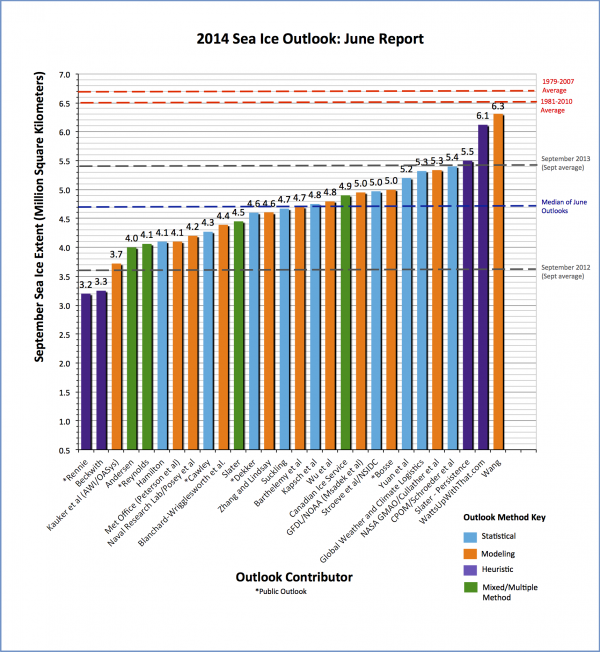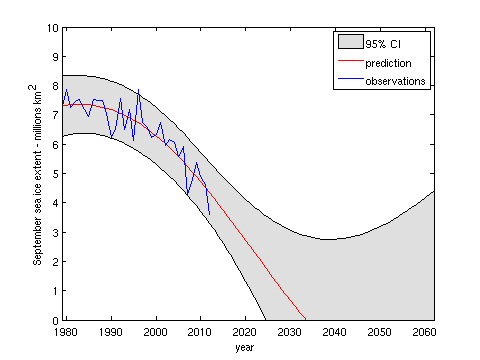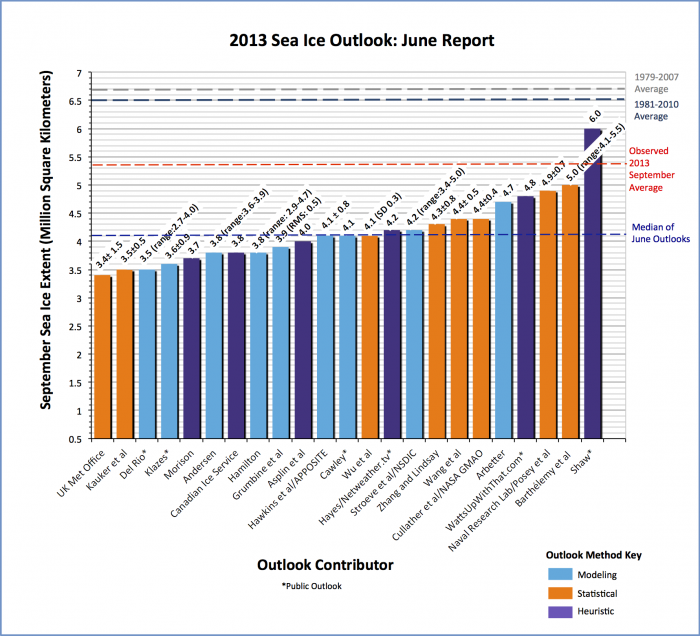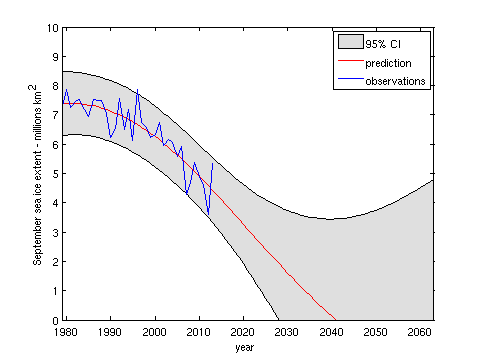
As September is rapidly approaching, I thought I would update my statistical prediction for this years September mean Arctic sea ice extent. I submitted the prediction in July to the Sea Ice Prediction Network, and it seems to be rather lower than the majority of the other predictions (as my prediction is listed as "Cawley"):
Figure 1. September mean Arctic sea ice extent predictions submitted to the Sea Ice Prediction Network in June 2014.
Before discussing this year's prediction, lets see how we fared last year. The prediction made last year is shown in Figure 2, and predicted a 2013 September Arctic sea ice extent of 4.1 ± 1.1 million square kilometres. The minimum Arctic sea ice extent of 5.10 million square kilometres was reached on September 13, 2013. Obviously this figure is substantially greater than the prediction, but still lies within the error bars of the projection, and so fits within the range of inter-annual variability considered plausible by the model. The September mean extent was 5.35 million square kilometres, which lies slightly above the credible interval. Note also that the model actually predicts the mean Arctic sea ice extent for the month of September, and so can be expected to somewhat over-estimate the September minimum.

Figure 2. Model prediction for September mean Arctic sea ice extent made in February 2013.
Figure 3 illustrates last year's prediction in comparison with other submissions to the sea ice prediction exercise. My prediction was very close to the median of the submissions, but all but one of the predictions substantially underestimated the actual mean extent. It should be noted however, that some models (such as mine) provide a prediction interval that includes the observed extent.

Figure 3. September mean Arctic sea ice extent predictions submitted to the sea ice prediction exercise in June 2013.
The prediction for this years September mean sea ice extent is shown below, the numeric prediction is 4.272 (+/- 1.129) million square kilometres. This is slightly higher than the prediction for 2013, but also the confidence interval is slightly wider. This seems reasonable as last year's surprisingly large minimum extent has a small effect on the overall trend since 1980, and the large variability we have seen in recent years has resulted in broader error bars, suggesting that natural variability may be greater than previously thought.

Figure 4. Model prediction for September mean Arctic sea ice extent made in June 2014.
The model predicts that an ice free summer is unlikely prior to 2028, but probable after 2041. However, this is likely to be a pessimistic projection, for the reasons discussed last year.
It is important to note that this is a purely statistical prediction, and doesn't take into account any real prior knowledge we have about the physics of sea ice accumulation and loss. I wouldn't regard this as a reliable predictor of Arctic sea ice, but perhaps as a simple baseline for comparison. A brief description of the method is as follows:
"I obtained from data for Arctic sea ice extent from 1979-2009 [2013 for the most recent prediction]...I then fitted a Gaussian process model, using the excellent MATLAB Gaussian Processes for Machine Learning toolbox (the book is jolly good as well). I experimented with some basic covariance functions, and chose the squared exponential, as that gave the lowest negative log marginal likelihood (NLML). The hyper-parameters were tuned by minimizing the NLML in the usual way."
Update: some errors corrected, thanks to billthefrog for spotting them (see comments).
Posted by Dikran Marsupial on Tuesday, 19 August, 2014
 |
The Skeptical Science website by Skeptical Science is licensed under a Creative Commons Attribution 3.0 Unported License. |